If you have the chance to visit Japan, you will undoubtedly come across this meaningful cultural symbol of the Land of the Rising Sun.
It is not difficult to spot colorful signs, charmingly described as above, on many streets in Japan. For Japanese children, they are known as “Tobita-kun.” Every day across Japan, from major urban intersections to quiet rural roads, Tobita-kun diligently works to protect young children at crosswalks.
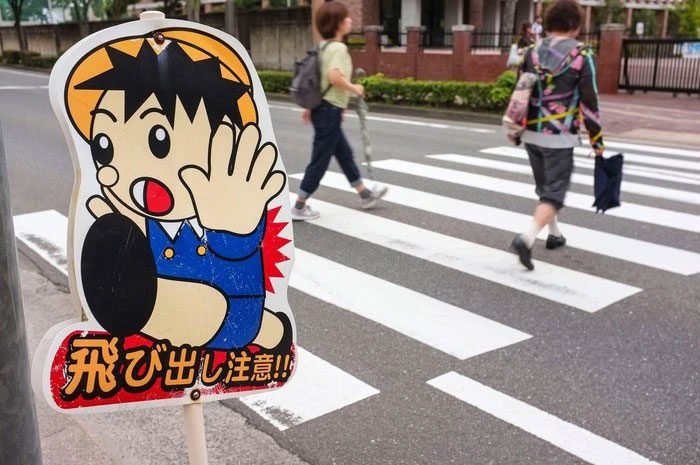
Tobita-kun.
Tobita-kun is a type of wooden sign that has served as a warning for drivers nationwide for over half a century to be cautious of real children who may suddenly dash into the roadway, especially near school zones. Often crafted elegantly by local councils, Tobita-kun has become an icon on Japan’s roads and has played a crucial role in revolutionizing road safety in the country.
In the years following World War II, Japan’s rapid economic recovery was not without its challenges. Across the nation, pedestrian and motorcyclist fatalities surged at an alarming rate during the 1960s, a period referred to by the Japanese as the “Traffic War.” During this time, a commentator noted that road fatalities exceeded those in some actual wars Japan had participated in.
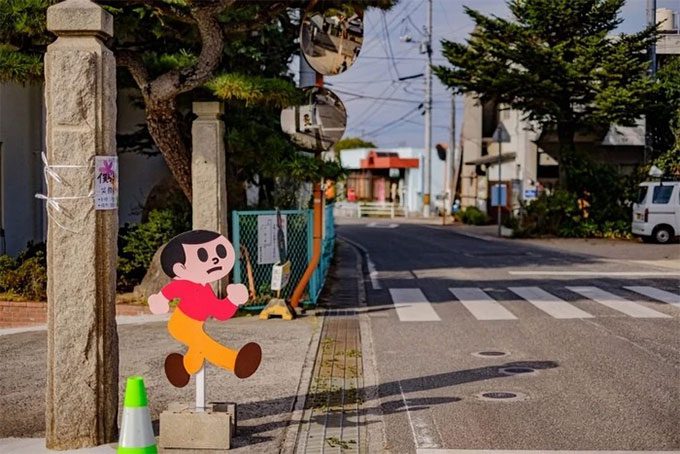
A classic Tobita-kun design can be seen at a street corner in Tonosho, Kagawa Prefecture.
Indeed, as reported by the National Institute for Land and Infrastructure Management (NILIM), there were 16,765 recorded fatal traffic accidents nationwide in 1970 – a rate of 16.33 per 100,000.
However, from that situation emerged a lasting cultural symbol – even one that is beloved. Tobita-kun originates from the term Tobidashi-bouya, meaning “the boy who jumps into the road.” The signs often feature the phrase tobidashi chuui – which translates to “Beware of children running.”
The design of Tobita-kun has evolved over history. They are typically made of wood, cut into the shape of a small cartoonish child, often depicted in mid-stride. Plastic versions also exist, though the extensive network of local volunteer safety councils in Japan continues to handcraft and paint wooden versions.
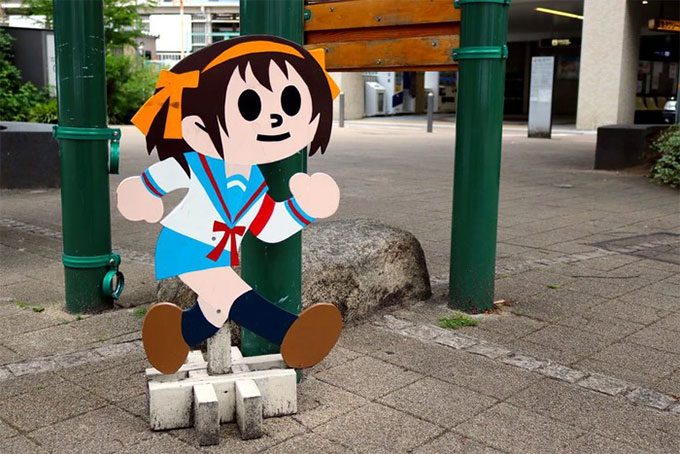
Anime designs are often used in local hand-painted signs, like this sign in front of Nishimiya-Kitaguchi train station.
The classic design – named “Series 0” by artist Jun Miura – was created in June 1973 by sign maker Yosei Hisada in Higashiomi, Shiga Prefecture, at the request of the town’s social welfare council. In this version, Tobita-kun is stepping onto the roadway in bright clothing with a classic hairstyle.
Fifty years later, Hisada and his son, Akihiro, still produce classic Tobita-kun signs for local parent-teacher associations, tourism organizations, and corporate clients requesting custom designs.
During a recent visit to the Hisada sign shop in Higashiomi, the workshop was filled with Tobita-kun signs waiting to dry. Akihiro Hisada stated, “We still make about 500 signs each year.”
The 50th anniversary of Tobita-kun is a time for celebration in Higashiomi. Spokesperson Ai Kawamoto mentioned in an email that the town has launched a commemorative website and is planning events to mark the occasion.
However, the Series 0 signs are not the only designs in use. Others, such as those found in Hiroshima, feature a hand raised, reflecting the way Japanese students are taught to cross the street, known as the Wataruyo sign (“I am crossing the street”).
As the classic Series 0 signs spread throughout Japan during the 1970s, numerous regional variants emerged, often depicting Tobita-kun dressed in local traditional attire. For example, signs around Koka are adorned in a ninja style. Other areas incorporate famous characters from Japanese animation and popular culture, including a homage to the distinct look of cartoonist and illustrator Jun Miura (long hair and sunglasses).
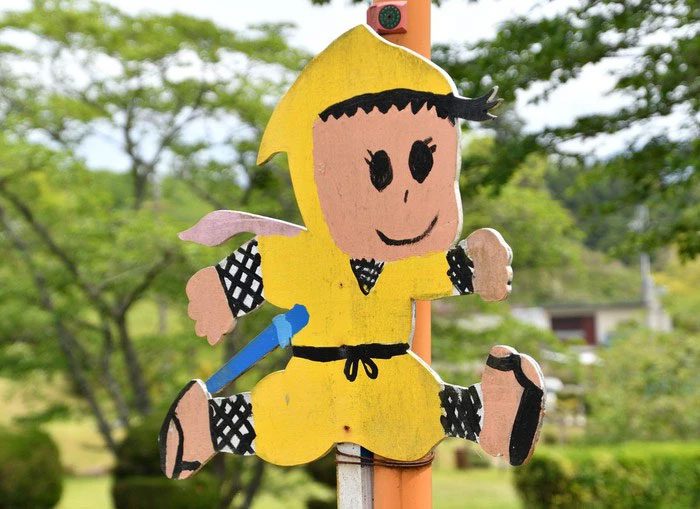
Designs often feature local flair. Tobita-kun in Koka is dressed as a ninja, as historically, this area was a famous training ground for ninjas.
Eighty-two-year-old Jiroku Yamagishi from the small city of Nanao began hand-making signs after his mother was involved in a traffic accident and passed away. “I want to reduce the number of people affected by accidents,” he said in an interview with Japanese media this year. To date, he has produced over 1,200 signs, which he donates to local education boards and city offices. “As long as I am able, I want to continue making signs,” he stated.
To explain the continued popularity of Tobita-kun, Japanese pop culture expert Taylor Atkins from Northern Illinois University suggests they are designed to promote local identity and community pride. Atkins noted in an email, “In a way, Tobita-kun is like the mascots of cities… that many towns and cities now have to promote and highlight.”
Atkins also acknowledges the popularity of cartoon styles in Japanese media. Not only traffic signs but also earthquake preparedness guides and many other public messages are now being distributed in animated forms.
In fact, Tobita-kun appears to be one of many factors winning the traffic battle in Japan. Other factors may include the advent of the shinkansen bullet train and the local railway network in general, which has alleviated dependence on cars. As David Zipper of Bloomberg notes, due to the extensive railway network, “driving in Japan has become a choice rather than a necessity.”
Additionally, Japan has some of the strictest laws against drunk driving in the world, and the number of traffic signals has increased from about 15,000 in 1970 to over 200,000 in 2013.
Combined, these measures have proven effective. According to NILIM, road traffic fatalities in Japan have dropped to just 25% of the peak level seen in 1970.
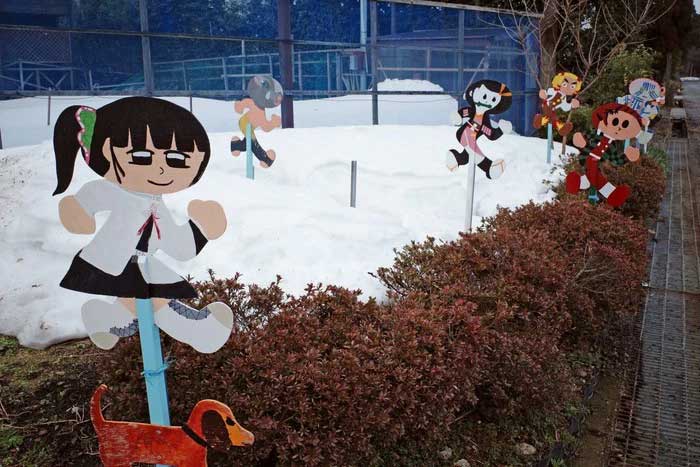
Design inspired by a popular manga/anime series from recent years.
As an indelible part of Japan’s traffic culture, Tobita-kun will continue to serve as a reminder for drivers to pay attention to their surroundings – not only to those crossing the street but also to the local towns they happen to drive through.


















































